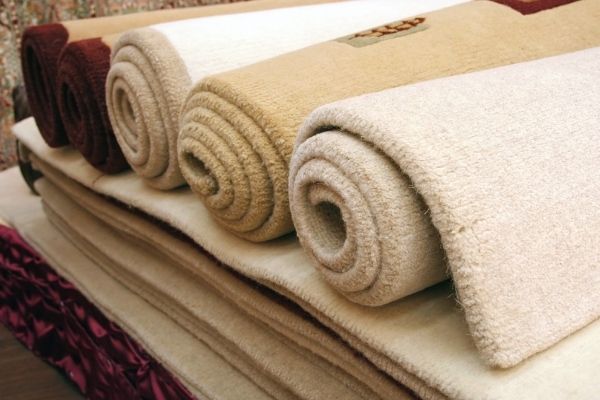Nylon is a strong and lightweight fiber that just about everyone has in their home. In fact, nylon is one of the most commonly used artificial fibers, with more than 8 billion pounds produced annually in the U.S. alone. First introduced in the 1930s as a substitute for silk, nylon is found in many common items these days. It’s used in ropes, nylon swimwear, activewear, luggage, backpacks, reusable shopping bags, and parachutes.
What is nylon? Is it plastic? Find all the answers to these questions below.
Quick Navigation
Is Nylon plastic?
Yes, nylon is a form of plastic made from crude oil that then put through a complex manufacturing process to make the strong fibres. These fibres are then used to create various products like nylon rope, fabric, bristles or even rigid products.
From a technical perspective nylon is part of a family of plastics called polyamides made from polymers called polyamides. These polyamides are long chains of molecules where the repeating monomers are joined by a particular type of link called an amide bond. Want to learn more about Plastic? Read our article What is plastic? A simple explanation.
The two-step chemical and manufacturing process for making nylon is complex. Strong polymers are created and bound together to create a durable fiber. The resulting product is heated and pumped through a spinneret machine and then cold-drawn into tough, elastic, and strong filaments.
Nylon is a thermoplastic, which means it can be melted and molded into products or drawn into fibers for making fabrics. It can be drawn, cast, or ejected to form fibers, wires, bristles, or sheets. These are then manufactured into yarn, fabric, and ropes.

What are the Characteristics of Nylon?
Nylon fabric is popular because it has many great properties.
- Nylon fabric does not absorb water.
- It dries fairly quickly and retains its shape well after laundering.
- It somewhat has the look and feel of silk. This is why it’s widely used in sheer hosiery, blouses, gowns, veils, and lingerie.
- Nylon is strong, elastic, easy to wash, and does not typically require specialty laundering.
- Nylon is relatively resistant to heat, UV rays, and chemicals.
Some characteristics that are not so good include
- It is bad at wicking moisture, making it a poor choice for use during vigorous physical activity.
- Unfortunately, nylon can burn quickly when it is exposed to an open flame.
- It takes quite a lot of energy to produce nylon, especially if you include extracting the crude oil.
- The process of making nylon also uses a great deal of water.
- Nylon is a plastic and, as with most plastics, can take a very long time to break down.
Why is nylon used so much?
In addition to the great properties listed above, nylon can also be easily adapted to a wide variety of applications by combining it with a large variety of additives.
It is used in clothing mostly for its durability and silk-like properties. It is also popular for its water-resistant and quick-to-dry properties.
Nylons’ water-resistant characteristics make them very popular for use in ropes and fishing nets. Great for the fishing industry but not so good for the planet as a good deal of the plastic in the ocean is discarded fishing nets.
What is nylon used for?
You will find nylon in many products that you use on a day to day basis.
Clothing
Fabrics made from nylon are used to make swimwear, activewear, socks, underwear, stockings, and pantyhose. Socks and stockings are one of the most common items made from nylon.
The versatility of nylon as a material is demonstrated by its use in outdoor gear like waterproof jackets and pants and its use in women’s lingerie and other apparel made from chiffon.
Ropes and fishing nets
Since nylon is strong, lightweight, and resistant to heat and cold, it is often used for making ropes and fishing nets. Synthetic ropes are typically more durable than ropes made from natural fibers.
There is a great company called WharfWarp that takes old lobster nylon ropes and transforms them into gorgeous mats, wreaths, pet leashes, and many other products for your home—keeping discarded fishing nets and ropes out of the ocean and in use. Find out more.
Cookware
Nylon is used in cookware because it has a relatively high melting point. Spatulas, slotted spoons, turners, forks, tongs, brushes, etc., are some kitchen items made from nylon.
However, these cooking utensils may not be the healthiest option. When they are heated at temperatures greater than their melting point, they release harmful elements that may contaminate food.
Nylon Carpets
Nylon is widely used as a replacement for wool fiber in carpets. It is considered the strongest type of carpet material and is resistant to mold. Nylon is used in about 65 percent of the carpets sold in the United States.

Other examples of Nylon include:
- sleeping bags
- seat belts
- dental floss
- tarpaulins
- toothbrush bristles
- fishing nets
- umbrellas
Is nylon biodegradable?
No form of nylon is biodegradable. Nylon is a synthetic plastic made of very strong polymers. Once you have finished with a product made from nylon, it will take a very long time to break down. Unfortunately, it often ends up in landfills or, worse still, in the ocean.
Can nylon fabric be recycled?
Given we now know the answer to the question “Is nylon plastic?” the next question that comes to mind is “can you recycle nylon?”. Whether or not nylon can be recycled largely depends on the form it takes, as some nylon items are easier to recycle than others.
Unfortunately, however, there are very few places that recycle nylon. This is especially the case for everyday people like you and me. Nylon products like ropes and clothing definitely don’t belong in your curbside recycling.
There are some good news stories, however. Aquafil is an Italian company that recycles old fishing nets, carpets, and other items into new nylon in a completely circular process. They make Econyl fabric and yarn that is used in many popular brands. You can learn more about Econyl here.
In particular, many swimwear brands use Econyl recycled nylon fabric in their collections. Check out our recycled swimwear series for some inspiration.
Brands using recycled nylon fabric
Noho
Noho believes furniture should fit with our values and our lifestyles. So they designed furniture that is kind to the planet and that looks and feels great. They create comfortable furniture that is created from waste. Their products are made using recycled nylon from discarded fishing nets and end-of-life carpets.
Prana
PrAna is a Hindu word defined as the universal energy and life-giving force that flows in and around us. They use recycled nylon called Econyl as well as recycled polyester. They also use recycled wool and Tencel fabric in some of their products.
They are transparent, responsible, and support charities to make a difference.
Yoga Democracy
Yoga Democracy has created a sustainable alternative for yoga gear. Using recycled nylon and polyester to produce gorgeous yoga and activewear. They are designed, printed, cut, sewn, packaged, and distributed under the same roof in Arizona, USA. Helping to minimize their overall impacts. They have some beautiful pieces.
Waterhaul
Waterhaul is a social enterprise based in Cornwall, England. They take plastic fishing nets from the ocean and transform them into sunglasses and glass frames as well as fishing knives and ocean clean-up gear.
Why You Should Buy Recycled Nylon
Recycling nylon is good for the environment. There are a lot of reasons why you should buy recycled nylon. Let’s look at some of them.
- Recycling Nylon saves it from ending up in landfills. There it can take 30 to 40 years to decompose.
- A huge part of the recycled nylon fabric produced comes from old fishing nets, which helps in diverting garbage from the ocean. According to the World Society for the Protection of Animals, more than 600,000 tons of fishing gear are dumped into oceans every year.
- Production of recycled nylon uses much fewer resources than manufacturing virgin nylon.By using nylon that has alraedy been produced you can decrease the negative effects of making it from raw resources such as:
- Nylon is basically a plastic made from petroleum which is a non-renewable resource. Drilling, fracking, and other methods used in harvesting petroleum are harmful to the ecosystem.
- The process of manufacturing nylon releases nitrous oxides into the atmosphere as waste. This Greenhouse gas is over 300 times stronger than carbon dioxide and contributes to environmental degradation and global warming.
- A large amount of water is used for cooling the nylon fibers during manufacturing, which is a source of water pollution.
Tips to reduce and reuse Nylon in your daily life
Below are a few tips for recycling or reusing items made from nylon.
Buy apparel and household items made from eco-friendly, natural materials like organic cotton, bamboo, linen, soy, and hemp. These are great alternatives to nylon.
Be conscious of your purchases. Check the labels and find out the materials used in the product before purchasing it. Buy used or recycled items wherever possible.
Support companies that are making a difference and offering takeback programs for recycling.
The popular outdoor gear manufacturer Patagonia uses recycled nylon in its products. According to them, the clothing and gear they made for the Spring 2021 season contained 90% recycled nylon. Not only that, but they have a program called Worn Wear, where they take back 100 percent of the clothing you return for recycling.
Another company, Timbuk2, offers a take-back program for their bags and backpacks. Once your nylon bag is worn out, you can mail it to the company at the address provided on their website. They will reuse or recycle as many items as they can. Apart from the cost of postage, there is no separate charge for the company’s recycling services.
If you have a backpack, sleeping bag, or other product made from nylon that you no longer want but are in good shape, consider donating it to a charity or thrift shop.
Nylon clothing is difficult to recycle, especially when blended with other materials like cotton or polyester. Clothing recycling is still not as well developed as we would like. However, there are some options available. If you want to learn what you can do with your old clothing, check out our article Clothing Recycling: How to recycle clothes sustainably.
Do whatever is within your reach to limit the use of nylon. Remember not to be too hard on yourself. Start slow and progress further into being a conscious buyer.
The Wrap
Nylon is a strong and lightweight synthetic fiber found in many common everyday objects, particularly clothing. Is nylon plastic? Yes, it’s a type of plastic, and so comes with all the problems associated with plastic. It isn’t easy to recycle and can take many hundreds of years to break down in landfills.
The good news is that there are companies like Aquafil that have found a way to recycle it. You can help support this industry by buying recycled nylon fabric products. Find some great brands in our series on recycled nylon swimwear and be inspired.
Want to learn more about recycled fabrics? Check out our other articles:
Learn more about recycled fabrics in our series:
Sources
- Textile School, 2018, Nylon Fiber and Characteristics
- Sewport, 2021, What is Nylon Fabric: Properties, How its Made and Where
- Creative Mechanisms, 2016, Everything You Need To Know About Nylon (PA)
- Kitchenicious, Are Nylon Cooking Utensils Safe? 3 Best Alternatives



















